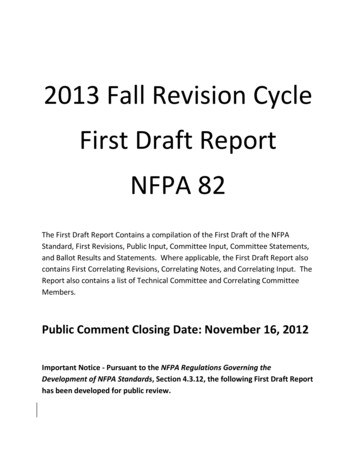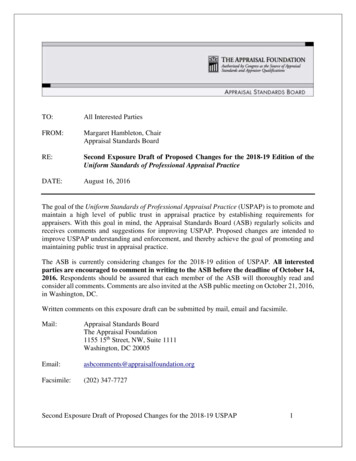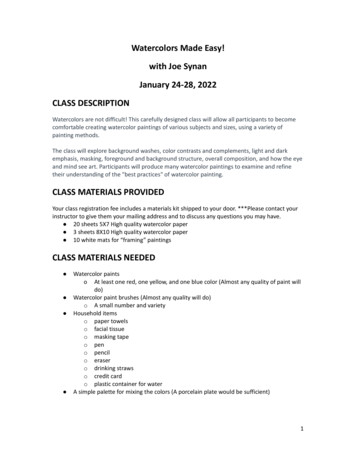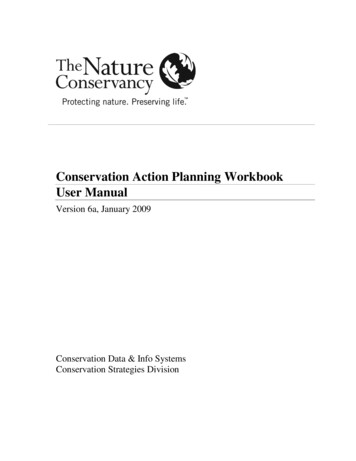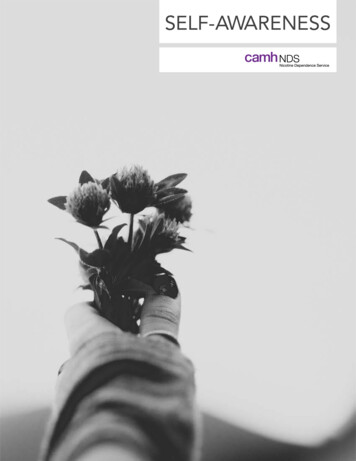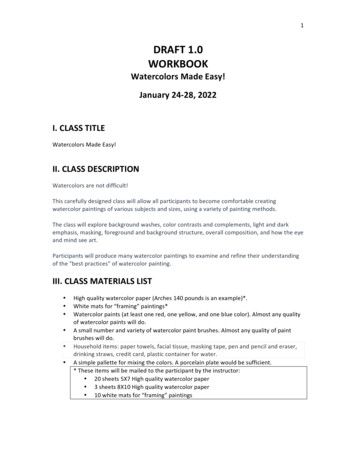
Transcription
1DRAFT 1.0WORKBOOKWatercolors Made Easy!January 24-28, 2022I. CLASS TITLEWatercolors Made Easy!II. CLASS DESCRIPTIONWatercolors are not difficult!This carefully designed class will allow all participants to become comfortable creatingwatercolor paintings of various subjects and sizes, using a variety of painting methods.The class will explore background washes, color contrasts and complements, light and darkemphasis, masking, foreground and background structure, overall composition, and how the eyeand mind see art.Participants will produce many watercolor paintings to examine and refine their understandingof the "best practices" of watercolor painting.III. CLASS MATERIALS LIST High quality watercolor paper (Arches 140 pounds is an example)*.White mats for “framing” paintings*Watercolor paints (at least one red, one yellow, and one blue color). Almost any qualityof watercolor paints will do.A small number and variety of watercolor paint brushes. Almost any quality of paintbrushes will do.Household items: paper towels, facial tissue, masking tape, pen and pencil and eraser,drinking straws, credit card, plastic container for water.A simple pallette for mixing the colors. A porcelain plate would be sufficient.* These items will be mailed to the participant by the instructor: 20 sheets 5X7 High quality watercolor paper 3 sheets 8X10 High quality watercolor paper 10 white mats for “framing” paintings1
2IV. SYLLABUSDAYMondayAMTIME(EST)10:00 AM Name/city Former/current career Personal goals for the course Objectives Draft agenda Basic rules Materials Questions Uniform Graded Mixed colorAll practice making washes10:30 AMDEMO: Washes10:45 AMPractice:washesDEMO: Colorwheel, colormixingPractice: Colorwheel, colormixingDEMO:Paintingwithout a brushPractice:paining withouta ountingpictures in matsReview11:30 AM11:40 AM12:00 PM12 PM – 6PM6:00 PM6:15 PM6:30 PM2IntroductionsCoursedescription11:15 AMTuesdayACTIVITIES10:15 AM11:10 AMMondayMid dayAGENDA ITEM7:00 PM10:00 AMReview ofindividual’spaintingsAdjournDEMO: mixing Color wheel from three basic colorsAll practice TreeStarburst flowersAll practiceTURN OFF CLASS RECORDINGPrivate practice: make more of the paintingsdemonstrated or paint what ever you wish.Meetings on ZOOM between instructor andindividual students–scheduled and on demand.Brief demonstrationReview of the methods and techniques that werepracticed, based on input from discussions withindividual students, perhaps including a shortdemonstrationIndividuals share their day’s painting, and receiveinput from instructor and class membersTURN OFF CLASS RECORDING Autumn leaf– Mixing colors
3AM10:15 AM10:30 AM10:40 AM11:00 AM11:15 AM11:30 AMTuesdayMid DayTuesdayPM11:40 AM12:00 PM12 PM – 6PM6:00 PM6:15 PMWednesday AM7:00 PM10:00 AM10:20 AM10:40 AM11:00 AM11:20 AMWednesday Midday11:40 AM12:00 PM12 PM – 6PM6:00 PMpaint on thepaperPracticeDEMO:marking todelineate anobjectPracticeDEMO: epractice;IndividualdiscussionsReviewReview ofindividual’spaintingsAdjournDEMO: eries6:15 PMReview6:30 PMReview ofAll practice flowers turtle landscape with trees and grassesAll practice cloudsAll practiceTURN OFF CLASS RECORDINGPrivate practice: make more of the paintingsdemonstrated or paint what ever you wish.Meetings on ZOOM between instructor andindividual students–scheduled and on demand.Review of the methods and techniques that werepracticed, based on input from discussions withindividual students, perhaps including a shortdemonstrationIndividuals share their day’s painting, and receiveinput from instructor and class membersTURN OFF CLASS RECORDING Ice cream cone Round rocksAll practice Trees with shadows TeacupAll practice Landscape with grass and trees Background for masked painting– saltAll practiceTURN OFF CLASS RECORDINGPrivate practice: make more of the paintingsdemonstrated or paint what ever you wish.Meetings on ZOOM between instructor andindividual students–scheduled and on demand.Discussion of the prospect of creating a series ofthree or more paintingsReview of the methods and techniques that werepracticed, based on input from discussions withindividual students, perhaps including a shortdemonstrationIndividuals share their day’s painting, and receive3
4ThursdayAM7:00 PM10:00 AM10:20 AM10:40 AM11:00 AM11:20 AM11:40 AMThursdayMid DayThursdayPM12:00 PM12 PM – 6PM6:00 PM6:15 PMFridayAM7:00 PM10:00 AM10:30 AMFridayMid dayFridayPM12:00 PM12 PM – 6PM6:00 PM7:00 aggeratingdark to lightcontrastPractice darkand ussionsReviewReview ofindividual’spaintingsAdjournDEMO:CompositionTo ssionsFavoritepaintingsreviewAdjourninput from instructor and class membersTURN OFF CLASS RECORDING Abstract landscapesAll practice Flower petalsAll practice LighthouseAll practiceTURN OFF CLASS RECORDINGPrivate practice: make more of the paintingsdemonstrated or paint what ever you wish.Meetings on ZOOM between instructor andindividual students–scheduled and on demand.Review of the methods and techniques that werepracticed, based on input from discussions withindividual students, perhaps including a shortdemonstrationIndividuals share their day’s painting, and receiveinput from instructor and class membersTURN OFF CLASS RECORDING Background/foreground Rule of one thirds Items: odd number ”Center of focus” (Use of the ”red dot”)Demonstrations and practice based on input fromthe students throughout the weekTURN OFF CLASS RECORDINGPrivate practice: make more of the paintingsdemonstrated or paint what ever you wish.Meetings on ZOOM between instructor andindividual students–scheduled and on demand.Review of the favorite paintings of each studentTURN OFF CLASS RECORDING
5BASIC RULES FOR OUR CLASSOverall Paint whatever you want to paint! Ask questions whenever something is on your mind Discuss anything you want to discuss with the instructorAttitude and self talk USE POSITIVE AFFIRMATIONS FREQUENTLY---“I am learning how to make watercolor paintings”---”I am enjoying painting with watercolors”---”More and more, I am making paintings that I like” AVOID NEGATIVE AFFIRMATIONS (“I cannot draw”)---Painting is not drawing!---Attractive watercolor paintings are based on form, color, and composition---The beauty of a painting can be that it is NOT a photo replication!MATERIALS/SUPPLIES FOR WATERCOLOR PAINTING Water (Tap water is usually sufficient). Your water doesn’t have to always be perfectlyclean. Even if the water appears to be colored, it may not affect the painting. If you arepainting with a light color, like a light yellow, you may want to have cleaner water.Sometimes the slightly dirty water makes for a good shadow in a lightly shaded area.Paper:-high quality paper really matters Especially for beginners-Suggested: Cold press, 140 pound, rough or regular, BRAND: Arches (Or equivalent)Paints (any quality is okay) generally speaking, more expensive paints have moreconcentrated pigment colorBrushes (any quality is okay) Always use the largest brush you can for any segment ofyour paintingMats for ”framing” (Recommended archival quality)Household items: container for water, plate for palette, straws, masking tape (wide ifyou have it), paper towels, facial tissues, steak knife or penknife, toothbrush, waxedpaper, saran wrap, rock salt (or table salt), etc.Surface: Most watercolor painting is done on a flat surface, not on an easel. It may bebest to have your painting surface very slightly slanted so that the water would flowdownward.5
6RULES FOR THE WATERCOLOR PAINTING PROCESSThere are no hard and fast unchanging everlasting rules!Paint light to dark it is hard There is no (useful) whiteto make a light color show up transparent watercolorwhen painted over a darkpaint the paper is notcolor.painted to leave the white.Leave white spaceswhen you can especially when mattingwith a white mat.6There is white Gouache, whichis an opaque watercolor.(center of red flowers). It cansometimes be used to paintlight over dark.Mistakes and “blooms” and “blossoms” are sometimes wonderful!
7Use the largest brush you can for a particularpassage or segment of your painting this is”efficient” and also enables paint to dry moreuniformly.If you have a lot of green and blue passages use some red.if you keep applying different colors of paintupon paint in watercolors it will end up looking“brown” and muddy.You can ”lighten” a paint passage by wettingthe surface and picking paint up with a papertowel, unless the pigment has extreme”staining” qualities.7
8WASHESA ”wash” is a covering of the paint surface with pigment that is usually quite diluted withwater.Uniform washesGraded washesMulticolored washesASSIGNMENT:Make one or more paintings of washesThese will be used later8
9FOREGROUNDS ON WASH BACKGROUNDS”Dark” flowersForest fireTrees, bushes, bouldersASSIGNMENT:Make one or more paintings with a light wash background and a darker foregroundCOLOR MIXINGALL COLORS FROM PRIMARY COLORSAll colors can be made from the three primary colors (not all ”hues” can be made, however)”Blacks” are more vibrant if they are made from their opposite colors, especially red and green)”Brown” usually results when all of the colors get muddied together!ASSIGNMENT:Combine some of the colors on your palette to make a black and a brown9
10BRUSHSTROKESA fun exercise is to make a row of flowers, using your different brushes. The larger brushes canbe used to make grasses and to bring all of the ground together, the medium-size brushes canmake leaves for the flowers, and the small brushes can be used to put the color of the blossomsin place.10
11COLOR WHEELCOLOR WHEEL, “OPPOSITE” COLORSThree primary colors: blue, yellow, redThree complementary colors: Green (blue plus yellow); orange (red plus yellow); purple (redplus blue). “Opposite” colors in a painting are often very attractive.OPPOSITES:Red and greenBlue and orangePurple and yellowASSIGNMENT:Make one or more paintings of the color wheel. (The color wheel can also be a nicebackground for a painting.)The human brain reflects the complementary colors from their primary opposites: Purpleopposite yellow; Orange opposite blue; Green opposite redASSIGNMENT:Experience the brain’s reflection of the complimentary color: Stare at the large red/orange circle below for about 30 seconds Then look at the white space below that image and you will notice that the largecircle is in a blue green color. This is the opposite of the red /orange of the dot.Our brain has the capacity for producing the opposite colors on the color wheel!11
12 12
13PAINTING WITHOUT A BRUSHORGANIC TREE--PAINTING WITH A STRAWOrganic tree on white backgroundOrganic tree on washbackgroundOther designs withpaint moved byblowing through astrawASSIGNMENT:Using a straw, make one or more paintings of an organic treeMATTINGPlacement: Make it interestingSignature: on the painting AFTER MATTING (not on the mat), small, with pencil .bottom right13
14MIXING PAINT ON PAPER (ALLA PRIMA)ASSIGNMENT:Make one or more paintings of a colorful autumn leaf, mixing colors on the paper.14
15MARKINGThe brain enables us to place the colors “inside the lines”“Loose” flowerTourtoiseTourtoiseASSIGNMENT: Make at least one painting using marking/outlining15
16INCISINGASSIGNMENT:Make one or more. paintings using incisingBLOTTINGCreating clouds (Kleenex– not paper towels). After you make a blot, make sure that you turn thetissue paper to a clean area, so you are not putting the pigment back down on the painting.ASSIGNMENT:Make at least one painting using lifting to create clouds16
17VOLUMEYou can use the density of color to demonstrate curvature and volume.ASSIGNMENT:Make one or more paintings demonstrating volume17
18SHADOWSShadow color: the artist is free to use any color that the artist wants!In certain paintings often times hey violet or purple color looks good.Shadow often times doesn’t have really sharp edges, but the color is gradually tapered.One tree (with shadowed trunk)cups & saucersASSIGNMENT:Make one or more paintings of a tree or a cup with shadows18
19TEXTURED SURFACESUnlike painting with oil or acrylics, it is difficult to demonstrate any texture on a regularwatercolor painting on paper. But there are a few techniques that enable an image suggests atextured surface.saltSaran wrap/wax paperToothbrush appliedpaintGrasses and trees Waxed paperASSIGNMENT:Make one or more paintings using different textures19
20MASKINGMASKING ABSTRACT LANDSCAPESAbstract landscapes with pieces of tape, sometimes torn to demonstrate Mountain forms.ASSIGNMENT:Make one or more abstract landscape paintings masking with tape, cut to look like petals ofthe flower.MASKING FLOWERASSIGNMENT:Make one or more flower paintings masking with tape20
21THE EYE—RODS AND CONESLight passes through the pupil to the retina (back of the eye).There are rods and cones in the retina. Cones are used in daylight vision. Cones perceivecolors. Rods are used in nighttime vision. Rods do not see colors.Rods and cones pass signals to the brain. The eyes do not see. The brain ”sees”.EXAMPLE: vibrating poppiesORIGINAL PAINTING IN COLORGREYSCALEObservers report that, when viewing this painting, the poppies seem to vibrate.A gray scale image has the red poppies disappear.The poppies red color is opposite (on the color wheel) the green color of the field.Cones message: Look at the dramatic contrast between the poppies and the field!Rods message: I don’t see any poppies!Hence the vibration!EXAGGERATING LIGHT AND DARK CONTRASTSIn a study which tracked “where the eye went” when looking at a painting, the eyes focused on”interesting features”(the person), and especially on the area where there was extreme dark tolight contrast.ORIGINAL PAINTINGTRACING EYE MOVEMENT21
22Ice cream coneLighthouseASSIGNMENT:Make a painting of one or more ice cream cones and light houses, emphasizing the differencebetween darks and lights, and possibly using contrasting colors.22
23COMPOSITIONBACKGROUND “FUZZY”; FOREGROUND “SHARP”Background, especially in landscapes, is “fuzzy”, with soft edgesThe foreground is sharper.23
24RULE OF ONE THIRDS the Center of interest should not be at the center of the picture. It shouldinstead be at one third from the top or bottom and or one third from the right or left side.ODD NUMBER OF LIKE OBJECTS24
25CENTER OF FOCUS in a painting which is relatively nondescript, it is useful to add somethingthat Will be a focal point.25
26SNOW SCENESSnow scenes don’t require a lot of paint strokes! But it is important to put light colors, usuallyblues, to convey some shape in the snow. Also, snowflakes can be created by using the tip of apenknife or X-Acto knife to cut into the paper .BEACH SCENESBeach and desert scenes can capture the feeling of hot! The color of the sky can be used toconvey that.26
27PORTRAITSPortraits painted from a photograph are best done if the painting is done upside down!Our brains have too much familiarity with the human face (or, for that matter an animal face)and we do not paint what we see. If we follow the discipline of painting upside down we willlearn to paint just what we see and the painting will be more realistic, once we turn it over andlook at it!WATERCOLOR WITH PEN AND INKPen and ink drawings can be accentuated with a little bit of watercolor. Only a little bit need tobe added to spice up the otherwise black-and-white drawing.27
28ABSTRACT PAINTINGAbstract watercolor painting can be especially fun! However it must be done with a little bit ofdiscipline. It is usually best to start with some light colors and, if necessary cover them withdarker colors.28
29CAMPBELL SCHOOL SCENESThere are many interesting scenes and vistas around the Campbell school. Take some time andphotographs and make some paintings of what you see here29
3030
31SERIES“Paint something more than once”It is a good practice to make a series of paintings of similar subjects or of the same subjectpainted in different ways.31
32JOE SYNAN- BIOGRAPHYJoe Synan is an art student and art entrepreneur, in his latest career direction.In the past 13 years, Joe has been a student at the Glassell School of the Museum of Fine Arts in Houston.In addition, he has attended 15 classes in the painting studio at the John C. Campbell school in BrasstownNorth Carolina. He has attended painting classes at the Anderson Ranch Art Center in Colorado, and theTruro School of Art on Cape Cod.For six years, Joe has been a volunteer instructor in watercolor painting for The Art Project in Houston.This program enables homeless and previously homeless persons to create and sell their watercolorpaintings. In addition, for the past 5 years, Joe has volunteered to create and lead a watercolor paintingclass for The Women’s Home, a Houston-based recovery center. In 2021 he is teaching that class remotelythrough ZOOM.Joe has been selected to show his art in a number of Texas art shows, including the Woodlands WaterwayArt Festival, In Woodlands Texas. This art festival is regularly rated as one of the top 10 regional art fairs.Joe continues to practice as a leadership and team effectiveness consultant who has successfully servedorganizations and teams in the corporate, non-profit, and public sectors. He is founder and President ofLeadingwell Associates, a consulting practice he has led since 1988. For the past dozen years, Joe has beenon the faculty of the Glasscock School at Rice University, teaching leadership workshops.Joe has three degrees in nuclear engineering, two from M.I.T. and one from Notre Dame. He has attendedthe University of Virginia, Executive Business Program, and obtained a masters degree in Theology at theUniversity of St. Thomas in 2001. He is a native of Zanesville, Ohio and resides in Kingwood, Texas with hiswife, Susan, a Psychotherapist.Their son, Chris, a graduate of the University of St. Thomas and South Texas College of Law, and theirdaughter, Jenny, is a graduate of New York University, and received her Masters Degree in Social Work asa Human Rights Professional at Alice Salomon University in Berlin, Germany.An active runner and mountain hiker - Joe has completed 8 Marathons and 9 Half Marathons since 2005,and has hiked to the highest point in 46 states. In 2020 he completed 2 half marathons and logged 3000miles in his daily bike rides.32
transparent watercolor paint the paper is not painted to leave the white. There is white Gouache, which is an opaque watercolor. (center of red flowers). It can sometimes be used to paint light over dark. Leave white spaces when you can especially when matting with a white mat. Mistakes and "blooms" and "blossoms" are sometimes .


